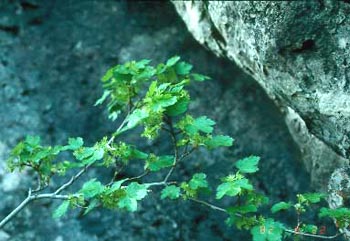Rocky Mountain Maple

Common Name(s):
Rocky Mountain Maple
Mountain Maple
Scientific Name:
Acer glabrum Torr.
Scientific Name Synonyms:
Acer tripartitum Nutt. ex. Torr. & Gray
Symbol:
ACGL
Description:
Life Span: Perennial
Origin: Native
Season: Deciduous
Growth Characteristics: Rocky Mountain maple is a small, rather delicate-looking tree, with opposite, ascending to erect branches, rounded twigs, and a narrow crown. At maturity, it can exceed 25 feet high. Rocky Mountain maple is usually tall and spindly in closed stands, with a more dense and brushy growth form in open stands. Though it may have a single dominant stem, Rocky Mountain maple most often occurs as a multi-stemmed shrub 5 to 6.5 feet tall.
Flowers/Inflorescence: Flowers are greenish-yellow, appearing early in the spring in small clusters. Male and female flowers are on separate trees.
Fruits/Seeds: Seeds occur in pairs, attached by their seed coat. On the unattached end of each seed are broad membrane-like wings. This arrangement is known as a double samara.
Leaves: Arise from twigs in pairs, each leaf blade seldom exceeding 3 ¼ inches in diameter. The leaf margin is coarsely and sharply toothed, divided into three (occasionally five) distinct lobes. The leaves often have reddish fungus spots on the surface. In the fall they turn from light green to reddish-orange before dropping.
Stems: Twigs are red-brown, and rounded in cross section. The bark is generally smooth until maturity, when small fissures appear. It is gray-brown in color. The wood of Rocky Mountain maple is heavy, hard, and brownish in color.
Ecological Adaptions:
Rocky Mountain maple occurs on wetlands, streambanks, canyons, and upland mountain slopes. Though it occurs on both moist and dry sites, Rocky Mountain maple is more closely tied to drainages in arid zones of its distribution, but occurs on drier exposures northward and at higher elevations. On upland sites, Rocky Mountain maple grows on lower, mid, and upper slopes, alluvial terraces, summits, ridgetops, snow chutes, and talus slopes. It usually occurs between 5,000 and 12,000 feet. Following stem damage or top-kill, Rocky Mountain maple readily resprouts from the root crown.
Soils: Rocky Mountain maple occurs on silty, loamy, sandy, gravelly, and rocky soils, with a moderately acidic to slightly basic pH.
Associated Species: Subalpine fir, quaking aspen, chokecherry, pinegrass.
Uses and Management:
Rocky Mountain maple is important for watershed cover and browse for wildlife and domestic animals.
There is little evidence of extensive use by humans of this species, fuel being its main use. Mostly, it has added to the attraction of the canyons and mountainsides.
Some Native American tribes favored the straight stems of Rocky Mountain maple for arrow shafts, and the pliable wood for snowshoe frames. The Navajo's used an infusion of twigs as an anti-rheumatic and to treat swelling. The young shoots can be harvested in the spring and cooked like asparagus.

